Search Results for and texture
Explore AI generated designs, images, art and prompts by top community artists and designers.

Lonely lighthouse in endless fog and heavy seas , colorful fractal plasma energy vortex. a pulling Prism Assemblage Encapsulated within shaped of sailboat with torn sails shrouded in mist navigating in the middle of stormy turquoise ocean. The most striking element is the sky . Thick , billowing clouds stretch across the sky , heavy and textured with tones of grey , brown , and hints of blue. ,

A small child stands close to a brightly lit Christmas tree , positioned on the right side of the scene and facing left , gazing upward with wide , focused eyes. The child wears soft , light-colored pajamas with a gentle printed pattern , the fabric slightly loose and rumpled , suggesting a quiet moment at home. Their posture is upright but cautious , body leaning subtly forward , hands resting near their sides as if resisting the urge to touch. The tree fills the left half of the frame , dense with warm white and multicolored lights that glow softly against the surrounding room. Instead of traditional ornaments , the branches are heavily decorated with plush toys and small character figures in pastel yellows , blues , pinks , and greens , layered thickly from top to bottom. At the base of the tree , a shallow box overflows with additional stuffed animals , spilling outward and crowding the floor with color and soft shapes. The carpet beneath is pale and textured , catching scattered reflections from the lights above. The background recedes gently into soft focus , with hints of furniture and blue-toned walls framing the scene. The atmosphere is intimate and hushed , defined by warmth , proximity , and the suspended moment just before movement , where curiosity holds perfectly still. ,

descends the private jet stairs with effortless poise , long waves catching the breeze as runway lights glow behind her , highlighting the drama of the moment. Luxury and elegance radiate from every detail of the scene. Hair: Long , effortless yet polished waves , softly lifted by wind. Subtle movement and layered highlights enhance realism , with strands gently framing the face. Outfit: Floor-length black blouse with golden embroidery paired with a flowing white lehenga richly decorated with golden designs with a thigh-high slit , smiling gracefully while holding colorful dandiya sticks , adorned with dripping Cartier diamonds. white lehenga flows naturally , catching runway and jet lights , showing subtle folds , sheen , and texture. Props/Textures: Oversized designer sunglasses reflecting ambient light , vintage Louis Vuitton travel trunk at the side. Runway lights and jet stairs polished , reflecting softly onto fabric and jewelry. Skin & Face Texture: Ultra-realistic cinematic detail. Visible pores , natural highlights along cheekbones , nose , collarbones , and shoulders from spotlight and runway reflections. Lips soft satin sheen; eyes sharp beneath designer sunglasses reflecting subtle light. Micro-expression conveys effortless confidence. Camera & Lens: Canon EOS R5 , wide-angle lens. Wide cinematic framing emphasizing her full figure , white lehenga flow , and the stairs with runway lights. Angle: Slight low-angle to accentuate presence , luxury , and upward motion from stairs , capturing both movement of gown and sparkling diamonds. Lighting: Spotlights combined with ambient jet and runway lights. Highlights sculpt skin , gown , and diamonds while shadows add cinematic depth. Vibe: Grandiose , high-fashion luxury — cinematic editorial capturing the moment of stepping into ultimate glamour and sophistication. ,

A breathtaking fantasy landscape featuring a grand , ancient structure perched on the edge of a serene lake , surrounded by towering mountains (majestic:1.2). The architecture showcases intricate details , with gold and stone elements illuminated by warm sunlight (golden hour:1.2). In the foreground , a large circular mosaic with intricate designs is situated on a stone pathway leading to the water , displaying vibrant colors and textures (vivid:1.2). The scene is tranquil , reflecting the calm water that mirrors the mountainous backdrop , with lush greenery and subtle flower detailing adorning the rocky outcrops. Emphasize clear details and avoid any modern elements or unnatural colors to maintain an immersive fantasy atmosphere. (negative: modern elements , dull colors) Use a wide-angle perspective to capture the grandeur of the setting , ensuring depth and detail. ,

Half Body Fantasy Fashion photo of a 24 year old Asante-Bhotia female classic Hollywood beauty with Hesitant uncertainty expression. Her body is Slim waist with defined obliques that taper into a tight core , toned muscles , abs , small breast , flat chest. She has Warm beige skin with a subtle flush across the nose and cheeks. The skin pores and texture are clearly visible and in focus. Her Eyes with angular curves , Bold , neon green eyes , framed by long , elegant eyelashes. Her haircut is Asymmetrical cut with one side resembling fish scales , the other fins. Her haircolor is Mystic purple. Her eyebrows are Soft and airy shaped , complementing her delicate facial features. She is dressed with Blue storm cloud bandeau that occasionally sparks with lightning , gray pants that swirl with contained mist , midriff visible. in the background A cyberpunk organ harvesting facility with life support systems keeping victims alive , neon lights reflecting off surgical steel and flowing blood the model is lighted with soft natural lighting ,

In a fantasy setting , a mystical character clad in intricate armor with fine details (detail:1.5) stands beside an adorable dragon creature. The character has ethereal silver hair and wears a stylish , form-fitting outfit adorned with gemstones (style:1.2). The dragon’s large , expressive eyes capture the viewer's attention , highlighting its gentle demeanor and textured scales (texture:1.4). Soft , atmospheric lighting creates a dreamy ambiance , with a subtle snowfall adding to the enchantment of the scene (lighting:1.3). Both subjects share a moment of connection , their hands nearly touching , suggesting a bond of friendship. The background features a serene , icy landscape that complements the mystical theme , while the composition emphasizes both subjects in the foreground (composition:1.5). Negative prompts: avoid harsh shadows and overly bright colors to maintain the magical feel. ,

In a misty , verdant landscape , two intricate alien spaceships (spaceships:1.2) hover dynamically above lush cliffs , showcasing advanced mechanical designs and glowing amber lights (glowing:1.1). The atmosphere is ethereal with soft , diffused lighting filtering through dense fog (fog:1.2) , creating a mysterious yet awe-inspiring scene. Capture the contrast between the rugged structures of the ships and the organic environment , emphasizing the tension between technology and nature. The composition centers on the ships , framing them with rich greenery and ensuring they dominate the visual narrative. The color palette should revolve around earthy tones with metallic blues and greens (earthy tones:1.1) to highlight futuristic elements. Aim for a highly detailed and textured finish to enhance realism , avoiding cartoonish features (style:1.3). The overall mood should be one of wonder and suspense , with hints of adventure and exploration. ,

A futuristic space scene featuring a massive , circular spaceship hovering above dense , textured clouds , with smaller spacecraft flying around it. The scene is set during twilight , casting a moody ambiance with soft lighting emanating from the ship's windows (lighting:1.2). The atmosphere should feel mysterious and expansive , emphasizing the isolation of the ship in space (atmosphere:1.2). Use high contrast to highlight mechanical details and textures of the spaceship (textures:1.1) , while clouds add volume beneath. Include intricate designs and industrial elements on the ship , capturing the essence of advanced technology (details:1.2). Avoid clutter in the foreground to maintain focus on the main subjects (negatives: clutter , chaos). Use a wide-angle perspective to convey depth and scale. ,

A breathtakingly intricate fantasy portrait of an ethereal chestnut-haired woman with long , flowing locks interwoven with delicate grass blades and vibrant autumn leaves , her deep gray eyes glowing with an otherworldly luminescence. She wears an ornate , form-fitting gown crafted entirely from clusters of luscious red and black currants , their glossy surfaces catching the light with a jewel-like sheen. Her regal presence is accentuated by elaborate accessories: shimmering mother-of-pearl inlays , deep ruby embellishments , and scattered gold dots that mimic starlight , all set against a backdrop of cracked glass textures that refract light in mesmerizing patterns. Flanking her are two majestic wolves—one as pure as freshly fallen snow , the other as dark as a moonless night—standing with quiet intensity , their fur rendered with hyper-polished shading that accentuates every strand. The forest around them is alive with detail: wild strawberries and blackberries burst with color , their leaves embroidered with intricate silk-like patterns , while ferns and horsetail plants sway gently in the misty air. Butterflies with iridescent wings flutter nearby , their delicate forms adding a sense of movement to the scene. The background is a rich tapestry of grained , volumetric floral motifs , where every petal and vine is rendered with crisp ultra-sharp focus , creating a sense of depth and texture. The atmosphere is thick with an enchanting fog that softens the edges of the scene while allowing the high-contrast elements—like the glowing eyes , glossy textures , and metallic accents—to stand out vividly. The rendering is noise-free , with thin , precise lines that define every detail , from the embroidered leaf patterns on her dress to the reflective sheen of gold and silver metals. The interplay of shiny and matte surfaces , combined with the lush colors of the forest and the rich tones of the berries , creates a visually stunning composition that feels both magical and hyper-realistic. ,

Portrait of a beautiful girl with curly blonde hair , who looks thoughtfully into the distance , lightly touching her curls with her hand. She is wearing a soft dark gray cashmere sweater. A train pulls away from the platform against a snowy train station , leaving a trail of smoke and steam that mixes with the falling snow. The three-quarter angle allows us to see the delicate line of her cheek and fine features , a waist-up portrait , foreground , illuminated by sidelight that gives her skin a warm glow. In the style of Thomas Kinkade , with intricate details and textures reminiscent of cymatic patterns , the image combines otherworldly fantastical elements with hypertrophied realism. ,

A young woman stands on the shore of the sea , dressed in simple yet elegant clothing. Her garments gently flutter in the sea breeze , and her expression is calm and contemplative. The detailed attire of the woman evokes a mystical traveler or an unassuming heroine , with subtle magical particle effects gently enhancing the enchanting atmosphere. In the background , the sea and a nearby large sailing ship can be seen. The woman's dynamic pose , combined with the use of light and shadows , creates an epic and immersive scene. This illustration is rendered in a classical pencil sketch style , emphasizing intricate details and smooth transitions between light and shadow. The fine linework captures the contours of the woman's elegant clothing and the subtle magical particle effects , while the soft shading adds depth and texture to the scene. The background features the vast sea and a large sailing ship , depicted with varying line weights to enhance the sense of distance and scale. The overall composition is balanced and minimalistic , focusing on the realistic portrayal of the woman's serene expression and the dynamic pose. The black-and-white realistic style brings out the timeless beauty and mystique of the scene , perfect for traditional art lovers seeking a detailed and artistic representation. ,

A young woman with long blonde hair , wearing a beautiful floral dress adorned with glowing flowers and sparkling embellishments , stands amidst a garden filled with vibrant roses. Her dress is sheer and light beige , with intricate floral designs in shades of orange , pink , yellow , and purple , seemingly woven into the fabric. The dress is adorned with glowing lights which accentuate the flowers. She has large , shimmering , golden-hued fairy wings with intricate details of small flowers. The wings are translucent and show a subtle iridescent shimmer. Her hair is styled in a loose , flowing braid and is accessorized with a delicate flower crown. Her skin appears smooth and flawless , with a hint of rosy glow , reflecting the light. The background is a vibrant garden of roses in various hues of pink , orange , and yellow. The background features a soft , impressionistic style , with blurred elements and a focus on the tones and textures of the flowers. There are subtle water droplets and bubbles dispersed throughout the scene , adding a magical , ethereal quality to the image. Natural light casts soft shadows , and the overall aesthetic emphasizes the beauty of the moment in a dreamy , romanticized setting. ,

A young woman with long blonde hair , wearing a beautiful floral dress adorned with glowing flowers and sparkling embellishments , stands amidst a garden filled with vibrant roses. Her dress is sheer and light beige , with intricate floral designs in shades of orange , pink , yellow , and purple , seemingly woven into the fabric. The dress is adorned with glowing lights which accentuate the flowers. She is wearing white lace garter belt and matching panties with sheer silk stockings. She is lifting her dress to reveal her panties and stocking tops. She has large , shimmering , golden-hued fairy wings with intricate details of small flowers. The wings are translucent and show a subtle iridescent shimmer. Her hair is styled in a loose , flowing braid and is accessorized with a delicate flower crown. Her skin appears smooth and flawless , with a hint of rosy glow , reflecting the light. The background is a vibrant garden of roses in various hues of pink , orange , and yellow. The background features a soft , impressionistic style , with blurred elements and a focus on the tones and textures of the flowers. There are subtle water droplets and bubbles dispersed throughout the scene , adding a magical , ethereal quality to the image. Natural light casts soft shadows , and the overall aesthetic emphasizes the beauty of the moment in a dreamy , romanticized setting. ,
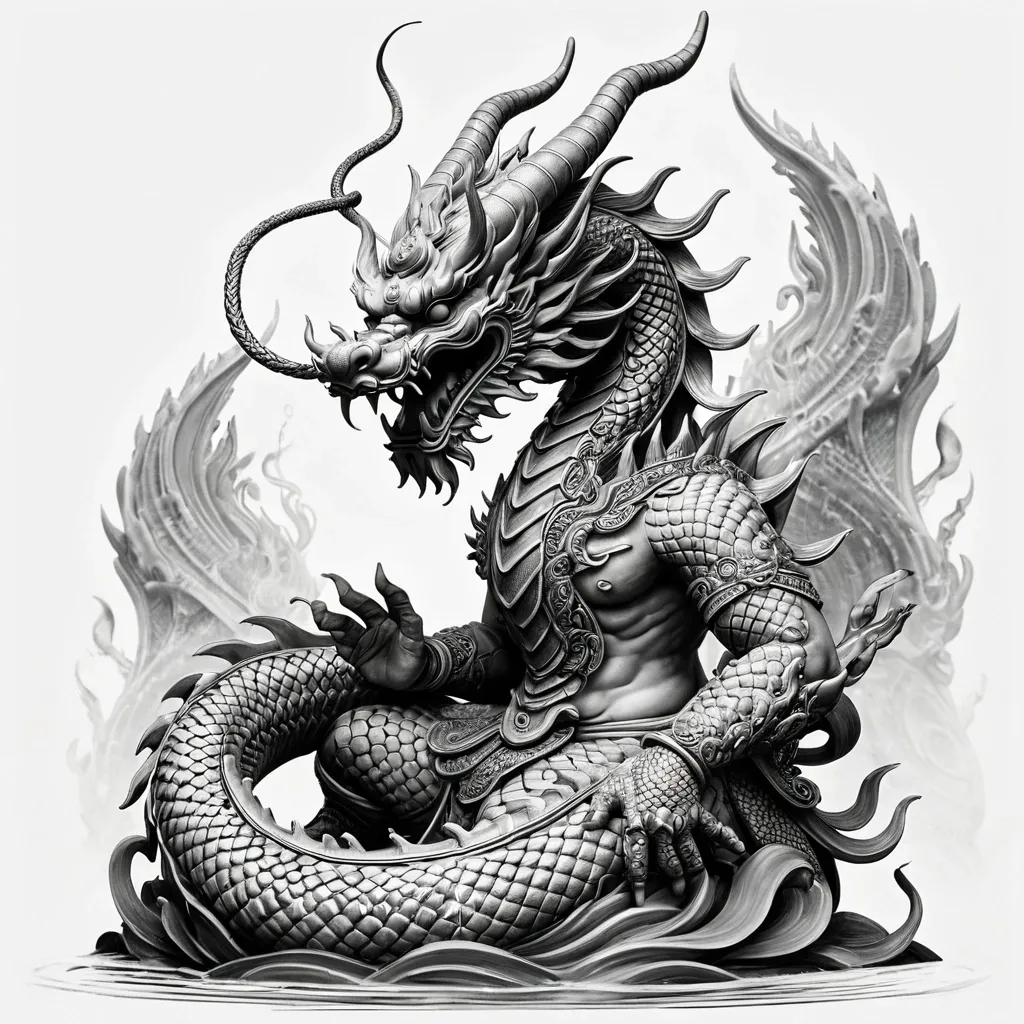
Intricate black and grey drawing , highly detailed and semi-realistic , designed as an advanced preparatory sketch for a tattoo. Full composition for outer bicep and shoulder. Central figure: traditional Thai Buddha , seated with one knee raised , head gently tilted to the side , serene and enlightened expression. Elegant drapery on his robe , with soft fabric folds and subtle shadows. Behind him , a majestic Thai Naga: a serpentine dragon with multiple ornate horns , sharp fangs , long finned whiskers , richly detailed scales and textured coils. The Naga winds behind the Buddha in an S-curve , dynamic and flowing , with sense of spiritual protection. Background: a delicate , elegant three-tier Thai pagoda , visible over the Buddha’s shoulder , with ornate roof details , curved tips , and shaded wood textures. Floating throughout the composition: soft , drifting Japanese cherry blossom petals , bringing poetic movement and lightness. The composition is harmonious , flowing with anatomical curves of the bicep and shoulder. Clear visual hierarchy , deep contrast , strong shading to emphasize volumes and textures. Drawing style: black and grey ink sketch , with high-definition pencil-like linework , bold outlines mixed with soft shading. No color. Not a tattoo render — pure art drawing with anatomical logic , atmospheric depth and rich symbolic detail. --- 🐉 Bonus — description précise du Naga thaïlandais : > The Thai Naga is a mythical serpent-dragon hybrid. It has a long , sinuous body like a snake , but with a fierce dragon face , a crown-like horned crest , flame-like eyebrows , and flowing fin-like ears. Its body is covered in symmetrical , overlapping scales , often detailed like fish or dragon scales. It exudes motion and power , and often coils with flowing elegance. Unlike Chinese dragons , it has a more divine and protective presence , often associated with water and temple guardianship. ,

A female Na'vi , the indigenous humanoid species of Pandora , perched confidently , her back have a butterfly-like wings. The entire outer and inner rims of the butterfly are densely embedded with hundreds of lifelike , realistic peacock feather , blinking , glimmering , and subtly moving. Each peacock feather has unique coloration and texture , some watery blue , others golden or dark brown , all appearing hyperreal and expressive. The butterfly’s surface is smooth , feathers or organic , slightly reflective , with faint glowing lines running along it like veins of energy. The focus must be on the perimeter being completely covered in multiple peacock feather. The background is a deep , star-filled void , enhancing the sense of mystery and scale. The image must be highly detailed , strange yet beautiful , evoking a presence that sees all directions at once. ,
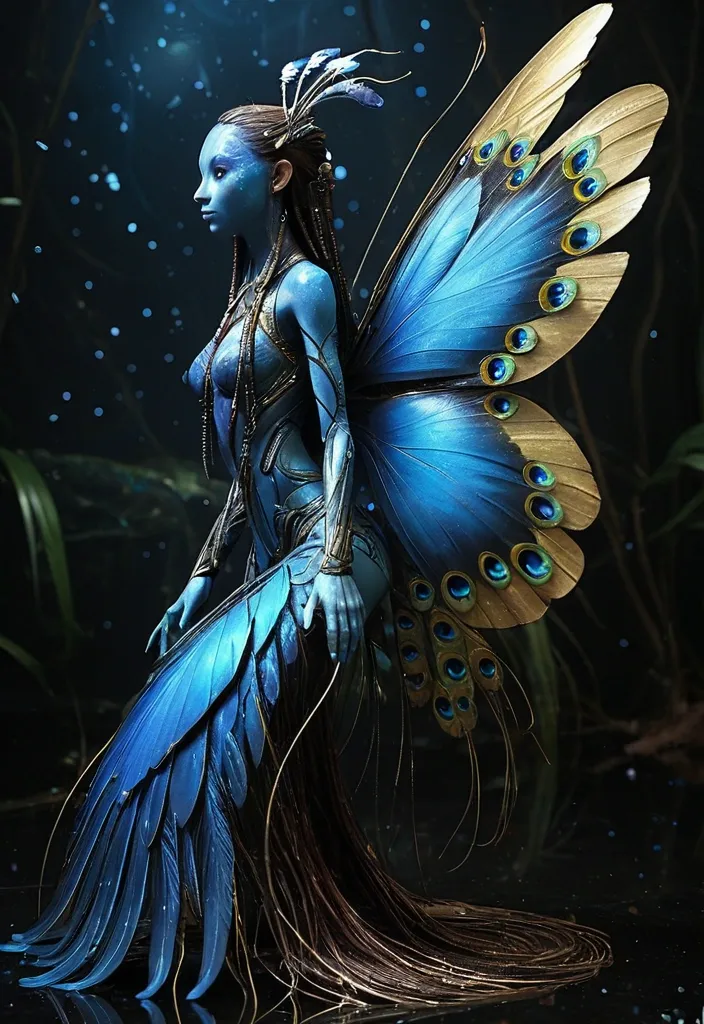
A female Na'vi , the indigenous humanoid species of Pandora , perched confidently , her back have a butterfly-like wings. The entire outer and inner rims of the butterfly are densely embedded with hundreds of lifelike , realistic peacock feather , blinking , glimmering , and subtly moving. Each peacock feather has unique coloration and texture , some watery blue , others golden or dark brown , all appearing hyperreal and expressive. The butterfly’s surface is smooth , feathers or organic , slightly reflective , with faint glowing lines running along it like veins of energy. The focus must be on the perimeter being completely covered in multiple peacock feather. The background is a deep , star-filled void , enhancing the sense of mystery and scale. The image must be highly detailed , strange yet beautiful , evoking a presence that sees all directions at once. ,
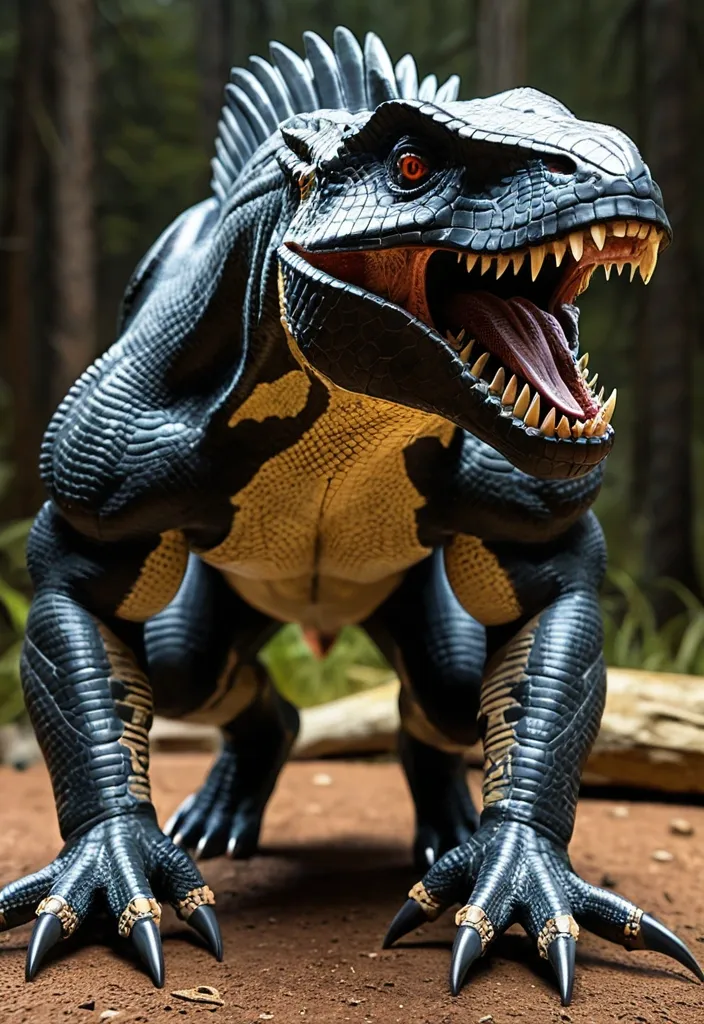
Physical Characteristics: Size & Build: Towering at around 15 feet tall and 40 feet long , Venenosus Rex exhibits a robust , muscular build with bulky , reduced hind legs adapted for powerful knuckle-walking quadrupedal locomotion , inherited from its Ape DNA. Its stance is low and intimidating , allowing swift bursts of speed and stability. Head: The head is a terrifying blend of Tyrannosaurus rex , Giganotosaurus , and Triceratops shapes—a broad , armored skull with a reinforced bony frill and horn-like protrusions from Triceratops , providing natural defense. Its jaw can open up to 90 degrees , snake-like , capable of delivering crushing bites able to shatter bulletproof glass. Skin & Camouflage: Covered in thick , overlapping Scelidosaurus-like osteoderm armor plates along the back and flanks , providing excellent protection against attacks. The skin contains chromatophore cells from cuttlefish DNA , allowing Venenosus Rex to dynamically change skin color , texture , and pattern for camouflage or intimidation. Arms & Claws: Long , powerful arms inspired by Saurophaganax and Ape DNA end in razor-sharp , hooked claws capable of slashing through armored prey and wielding tools for complex hunting strategies. Teeth & Fangs: Teeth are a deadly combination from the Inland Taipan’s retractable fangs , Komodo Dragon’s serrated teeth , and Northern short-tailed shrew’s sharp incisors , allowing it to pierce armor and inject highly toxic saliva into prey. Eyes & Senses: Equipped with specialized cranial cavities housing infrared vision , enabling night hunting and detection of body heat signatures. Its olfactory and auditory senses are exceptionally refined due to Utahraptor and Komodo Dragon ancestry. Unique Abilities: Extreme Environmental Resistance: Thanks to Tardigrade , Opossum , and Mongoose DNA , Venenosus Rex can survive extreme temperatures , radiation , dehydration , starvation , and bacterial infections. Its organs are shielded by trehalose gel , and its DNA is protected by specialized proteins against radiation damage. It can slow its metabolism down to 0.01% of normal , entering a near-hibernative state during harsh conditions. Toxic Saliva & Venom: Its saliva contains potent neurotoxins and anticoagulants , ensuring even minor bites are deadly over time. Combined with its retractable fangs , it can efficiently incapacitate prey or rivals. Camouflage & Stealth: Dynamic skin color and texture changes allow it to blend seamlessly into diverse environments or mimic threatening patterns to intimidate. Intelligence & Pack Hunting: Enhanced Utahraptor DNA grants high cognitive abilities , including planning , problem-solving , and social pack hunting tactics , making it a highly strategic predator. Tool Use: The combination of long , dexterous arms and ape DNA allows it to manipulate objects , set traps , or use environmental tools during hunts. Wide Jaw Opening: The ability to open its jaw at a 90-degree angle allows for impressive bite range and prey handling , intimidating foes with sudden wide gapes. ,
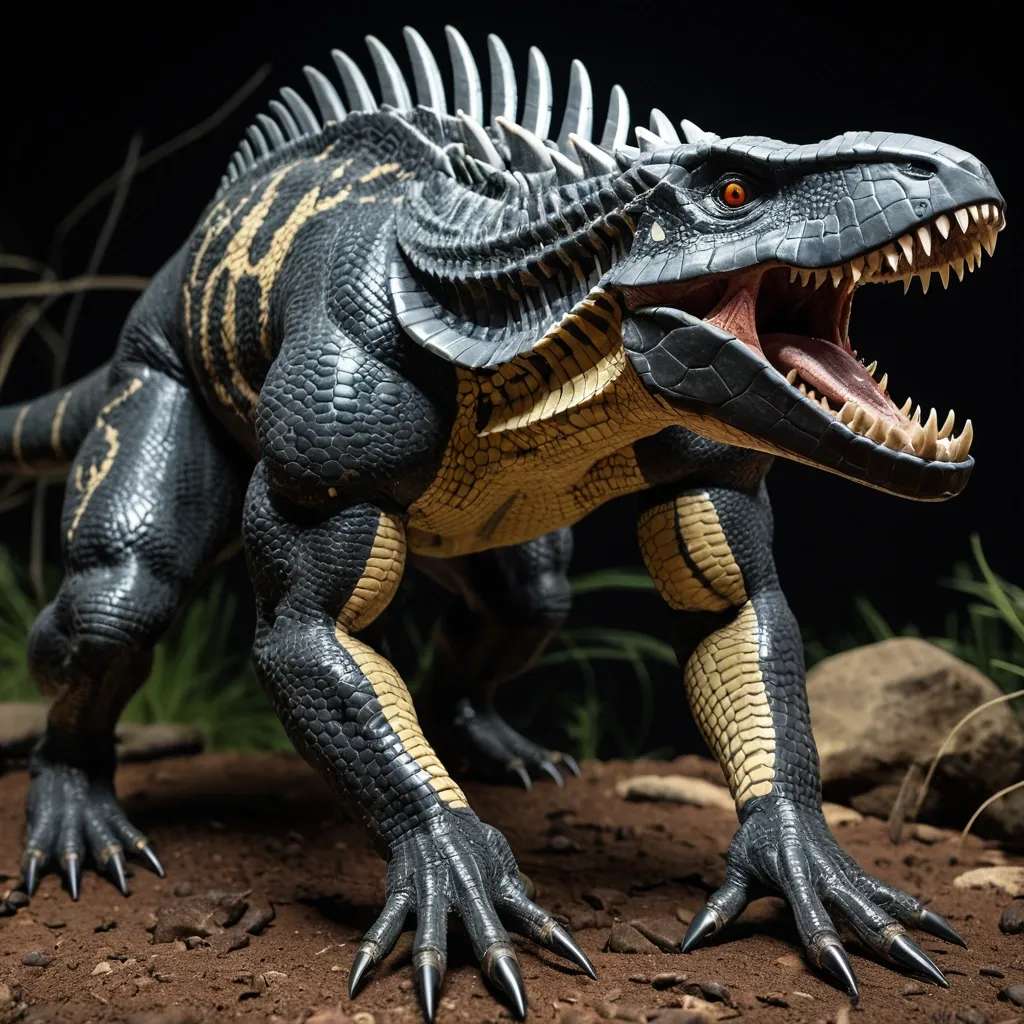
Physical Characteristics: Size & Build: Towering at around 15 feet tall and 40 feet long , Venenosus Rex exhibits a robust , muscular build with bulky , reduced hind legs adapted for powerful knuckle-walking quadrupedal locomotion , inherited from its Ape DNA. Its stance is low and intimidating , allowing swift bursts of speed and stability. Head: The head is a terrifying blend of Tyrannosaurus rex , Giganotosaurus , and Triceratops shapes—a broad , armored skull with a reinforced bony frill and horn-like protrusions from Triceratops , providing natural defense. Its jaw can open up to 90 degrees , snake-like , capable of delivering crushing bites able to shatter bulletproof glass. Skin & Camouflage: Covered in thick , overlapping Scelidosaurus-like osteoderm armor plates along the back and flanks , providing excellent protection against attacks. The skin contains chromatophore cells from cuttlefish DNA , allowing Venenosus Rex to dynamically change skin color , texture , and pattern for camouflage or intimidation. Arms & Claws: Long , powerful arms inspired by Saurophaganax and Ape DNA end in razor-sharp , hooked claws capable of slashing through armored prey and wielding tools for complex hunting strategies. Teeth & Fangs: Teeth are a deadly combination from the Inland Taipan’s retractable fangs , Komodo Dragon’s serrated teeth , and Northern short-tailed shrew’s sharp incisors , allowing it to pierce armor and inject highly toxic saliva into prey. Eyes & Senses: Equipped with specialized cranial cavities housing infrared vision , enabling night hunting and detection of body heat signatures. Its olfactory and auditory senses are exceptionally refined due to Utahraptor and Komodo Dragon ancestry. Unique Abilities: Extreme Environmental Resistance: Thanks to Tardigrade , Opossum , and Mongoose DNA , Venenosus Rex can survive extreme temperatures , radiation , dehydration , starvation , and bacterial infections. Its organs are shielded by trehalose gel , and its DNA is protected by specialized proteins against radiation damage. It can slow its metabolism down to 0.01% of normal , entering a near-hibernative state during harsh conditions. Toxic Saliva & Venom: Its saliva contains potent neurotoxins and anticoagulants , ensuring even minor bites are deadly over time. Combined with its retractable fangs , it can efficiently incapacitate prey or rivals. Camouflage & Stealth: Dynamic skin color and texture changes allow it to blend seamlessly into diverse environments or mimic threatening patterns to intimidate. Intelligence & Pack Hunting: Enhanced Utahraptor DNA grants high cognitive abilities , including planning , problem-solving , and social pack hunting tactics , making it a highly strategic predator. Tool Use: The combination of long , dexterous arms and ape DNA allows it to manipulate objects , set traps , or use environmental tools during hunts. Wide Jaw Opening: The ability to open its jaw at a 90-degree angle allows for impressive bite range and prey handling , intimidating foes with sudden wide gapes. ,
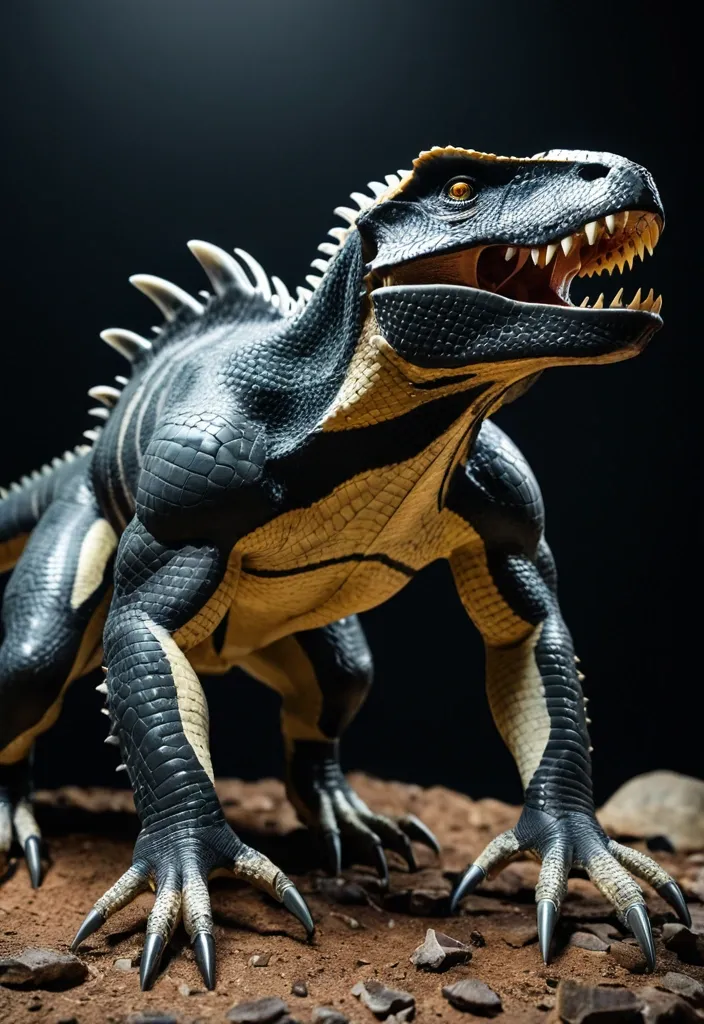
Physical Characteristics: Size & Build: Towering at around 15 feet tall and 40 feet long , Venenosus Rex exhibits a robust , muscular build with bulky , reduced hind legs adapted for powerful knuckle-walking quadrupedal locomotion , inherited from its Ape DNA. Its stance is low and intimidating , allowing swift bursts of speed and stability. Head: The head is a terrifying blend of Tyrannosaurus rex , Giganotosaurus , and Triceratops shapes—a broad , armored skull with a reinforced bony frill and horn-like protrusions from Triceratops , providing natural defense. Its jaw can open up to 90 degrees , snake-like , capable of delivering crushing bites able to shatter bulletproof glass. Skin & Camouflage: Covered in thick , overlapping Scelidosaurus-like osteoderm armor plates along the back and flanks , providing excellent protection against attacks. The skin contains chromatophore cells from cuttlefish DNA , allowing Venenosus Rex to dynamically change skin color , texture , and pattern for camouflage or intimidation. Arms & Claws: Long , powerful arms inspired by Saurophaganax and Ape DNA end in razor-sharp , hooked claws capable of slashing through armored prey and wielding tools for complex hunting strategies. Teeth & Fangs: Teeth are a deadly combination from the Inland Taipan’s retractable fangs , Komodo Dragon’s serrated teeth , and Northern short-tailed shrew’s sharp incisors , allowing it to pierce armor and inject highly toxic saliva into prey. Eyes & Senses: Equipped with specialized cranial cavities housing infrared vision , enabling night hunting and detection of body heat signatures. Its olfactory and auditory senses are exceptionally refined due to Utahraptor and Komodo Dragon ancestry. Unique Abilities: Extreme Environmental Resistance: Thanks to Tardigrade , Opossum , and Mongoose DNA , Venenosus Rex can survive extreme temperatures , radiation , dehydration , starvation , and bacterial infections. Its organs are shielded by trehalose gel , and its DNA is protected by specialized proteins against radiation damage. It can slow its metabolism down to 0.01% of normal , entering a near-hibernative state during harsh conditions. Toxic Saliva & Venom: Its saliva contains potent neurotoxins and anticoagulants , ensuring even minor bites are deadly over time. Combined with its retractable fangs , it can efficiently incapacitate prey or rivals. Camouflage & Stealth: Dynamic skin color and texture changes allow it to blend seamlessly into diverse environments or mimic threatening patterns to intimidate. Intelligence & Pack Hunting: Enhanced Utahraptor DNA grants high cognitive abilities , including planning , problem-solving , and social pack hunting tactics , making it a highly strategic predator. Tool Use: The combination of long , dexterous arms and ape DNA allows it to manipulate objects , set traps , or use environmental tools during hunts. Wide Jaw Opening: The ability to open its jaw at a 90-degree angle allows for impressive bite range and prey handling , intimidating foes with sudden wide gapes. ,
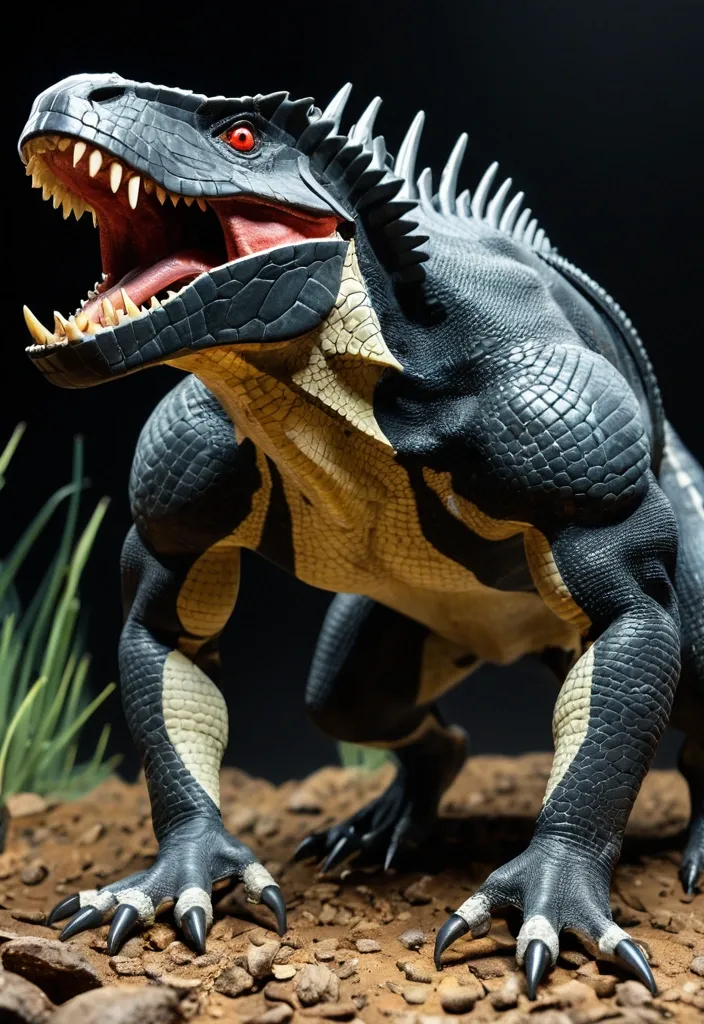
Physical Characteristics: Size & Build: Towering at around 15 feet tall and 40 feet long , Venenosus Rex exhibits a robust , muscular build with bulky , reduced hind legs adapted for powerful knuckle-walking quadrupedal locomotion , inherited from its Ape DNA. Its stance is low and intimidating , allowing swift bursts of speed and stability. Head: The head is a terrifying blend of Tyrannosaurus rex , Giganotosaurus , and Triceratops shapes—a broad , armored skull with a reinforced bony frill and horn-like protrusions from Triceratops , providing natural defense. Its jaw can open up to 90 degrees , snake-like , capable of delivering crushing bites able to shatter bulletproof glass. Skin & Camouflage: Covered in thick , overlapping Scelidosaurus-like osteoderm armor plates along the back and flanks , providing excellent protection against attacks. The skin contains chromatophore cells from cuttlefish DNA , allowing Venenosus Rex to dynamically change skin color , texture , and pattern for camouflage or intimidation. Arms & Claws: Long , powerful arms inspired by Saurophaganax and Ape DNA end in razor-sharp , hooked claws capable of slashing through armored prey and wielding tools for complex hunting strategies. Teeth & Fangs: Teeth are a deadly combination from the Inland Taipan’s retractable fangs , Komodo Dragon’s serrated teeth , and Northern short-tailed shrew’s sharp incisors , allowing it to pierce armor and inject highly toxic saliva into prey. Eyes & Senses: Equipped with specialized cranial cavities housing infrared vision , enabling night hunting and detection of body heat signatures. Its olfactory and auditory senses are exceptionally refined due to Utahraptor and Komodo Dragon ancestry. Unique Abilities: Extreme Environmental Resistance: Thanks to Tardigrade , Opossum , and Mongoose DNA , Venenosus Rex can survive extreme temperatures , radiation , dehydration , starvation , and bacterial infections. Its organs are shielded by trehalose gel , and its DNA is protected by specialized proteins against radiation damage. It can slow its metabolism down to 0.01% of normal , entering a near-hibernative state during harsh conditions. Toxic Saliva & Venom: Its saliva contains potent neurotoxins and anticoagulants , ensuring even minor bites are deadly over time. Combined with its retractable fangs , it can efficiently incapacitate prey or rivals. Camouflage & Stealth: Dynamic skin color and texture changes allow it to blend seamlessly into diverse environments or mimic threatening patterns to intimidate. Intelligence & Pack Hunting: Enhanced Utahraptor DNA grants high cognitive abilities , including planning , problem-solving , and social pack hunting tactics , making it a highly strategic predator. Tool Use: The combination of long , dexterous arms and ape DNA allows it to manipulate objects , set traps , or use environmental tools during hunts. Wide Jaw Opening: The ability to open its jaw at a 90-degree angle allows for impressive bite range and prey handling , intimidating foes with sudden wide gapes. ,
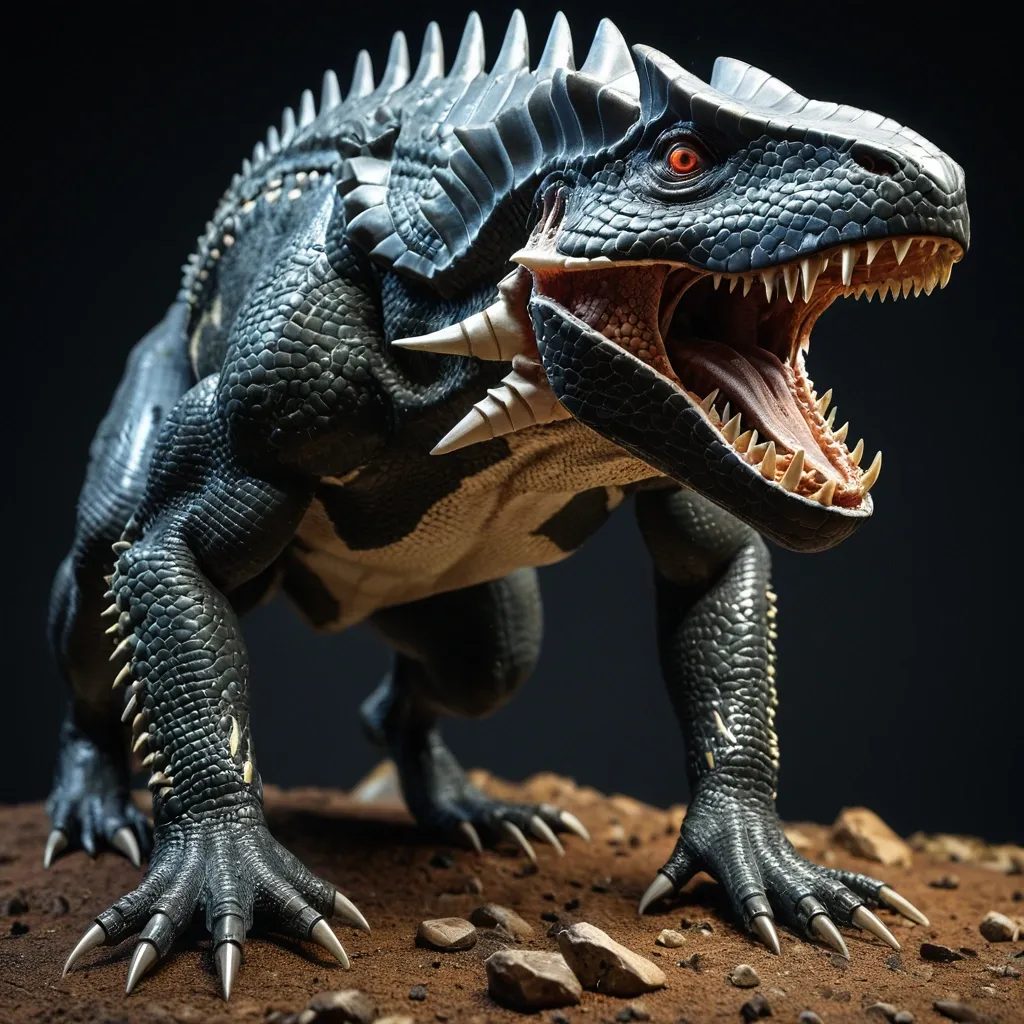
Physical Characteristics: Size & Build: Towering at around 15 feet tall and 40 feet long , Venenosus Rex exhibits a robust , muscular build with bulky , reduced hind legs adapted for powerful knuckle-walking quadrupedal locomotion , inherited from its Ape DNA. Its stance is low and intimidating , allowing swift bursts of speed and stability. Head: The head is a terrifying blend of Tyrannosaurus rex , Giganotosaurus , and Triceratops shapes—a broad , armored skull with a reinforced bony frill and horn-like protrusions from Triceratops , providing natural defense. Its jaw can open up to 90 degrees , snake-like , capable of delivering crushing bites able to shatter bulletproof glass. Skin & Camouflage: Covered in thick , overlapping Scelidosaurus-like osteoderm armor plates along the back and flanks , providing excellent protection against attacks. The skin contains chromatophore cells from cuttlefish DNA , allowing Venenosus Rex to dynamically change skin color , texture , and pattern for camouflage or intimidation. Arms & Claws: Long , powerful arms inspired by Saurophaganax and Ape DNA end in razor-sharp , hooked claws capable of slashing through armored prey and wielding tools for complex hunting strategies. Teeth & Fangs: Teeth are a deadly combination from the Inland Taipan’s retractable fangs , Komodo Dragon’s serrated teeth , and Northern short-tailed shrew’s sharp incisors , allowing it to pierce armor and inject highly toxic saliva into prey. Eyes & Senses: Equipped with specialized cranial cavities housing infrared vision , enabling night hunting and detection of body heat signatures. Its olfactory and auditory senses are exceptionally refined due to Utahraptor and Komodo Dragon ancestry. Unique Abilities: Extreme Environmental Resistance: Thanks to Tardigrade , Opossum , and Mongoose DNA , Venenosus Rex can survive extreme temperatures , radiation , dehydration , starvation , and bacterial infections. Its organs are shielded by trehalose gel , and its DNA is protected by specialized proteins against radiation damage. It can slow its metabolism down to 0.01% of normal , entering a near-hibernative state during harsh conditions. Toxic Saliva & Venom: Its saliva contains potent neurotoxins and anticoagulants , ensuring even minor bites are deadly over time. Combined with its retractable fangs , it can efficiently incapacitate prey or rivals. Camouflage & Stealth: Dynamic skin color and texture changes allow it to blend seamlessly into diverse environments or mimic threatening patterns to intimidate. Intelligence & Pack Hunting: Enhanced Utahraptor DNA grants high cognitive abilities , including planning , problem-solving , and social pack hunting tactics , making it a highly strategic predator. Tool Use: The combination of long , dexterous arms and ape DNA allows it to manipulate objects , set traps , or use environmental tools during hunts. Wide Jaw Opening: The ability to open its jaw at a 90-degree angle allows for impressive bite range and prey handling , intimidating foes with sudden wide gapes. ,
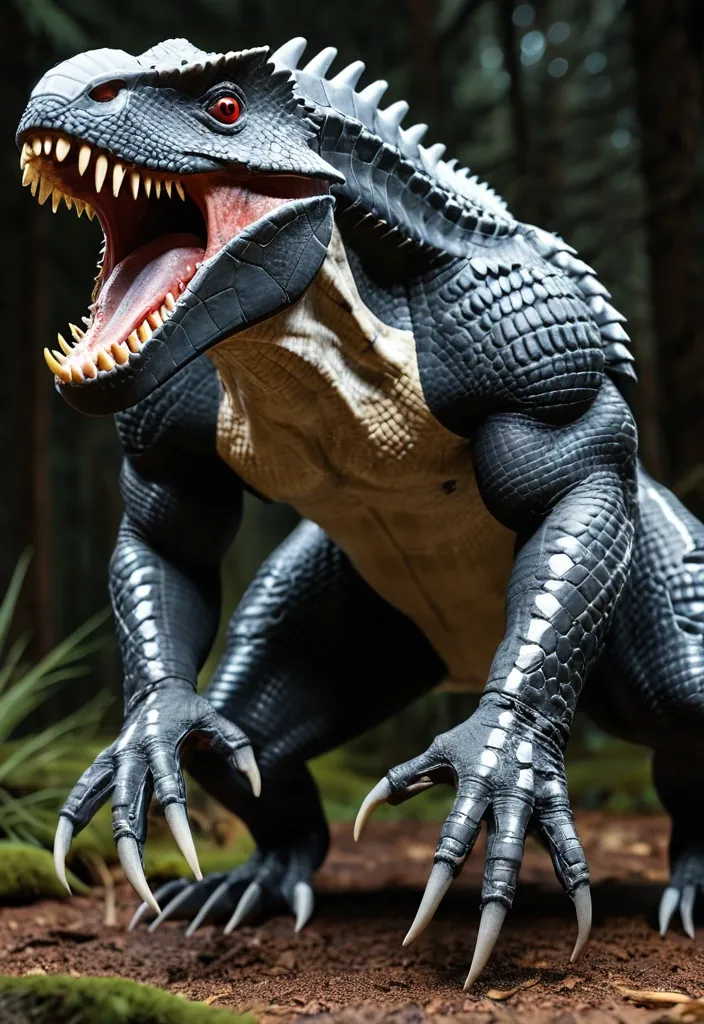
Physical Characteristics: Size & Build: Towering at around 15 feet tall and 40 feet long , Venenosus Rex exhibits a robust , muscular build with bulky , reduced hind legs adapted for powerful knuckle-walking quadrupedal locomotion , inherited from its Ape DNA. Its stance is low and intimidating , allowing swift bursts of speed and stability. Head: The head is a terrifying blend of Tyrannosaurus rex , Giganotosaurus , and Triceratops shapes—a broad , armored skull with a reinforced bony frill and horn-like protrusions from Triceratops , providing natural defense. Its jaw can open up to 90 degrees , snake-like , capable of delivering crushing bites able to shatter bulletproof glass. Skin & Camouflage: Covered in thick , overlapping Scelidosaurus-like osteoderm armor plates along the back and flanks , providing excellent protection against attacks. The skin contains chromatophore cells from cuttlefish DNA , allowing Venenosus Rex to dynamically change skin color , texture , and pattern for camouflage or intimidation. Arms & Claws: Long , powerful arms inspired by Saurophaganax and Ape DNA end in razor-sharp , hooked claws capable of slashing through armored prey and wielding tools for complex hunting strategies. Teeth & Fangs: Teeth are a deadly combination from the Inland Taipan’s retractable fangs , Komodo Dragon’s serrated teeth , and Northern short-tailed shrew’s sharp incisors , allowing it to pierce armor and inject highly toxic saliva into prey. Eyes & Senses: Equipped with specialized cranial cavities housing infrared vision , enabling night hunting and detection of body heat signatures. Its olfactory and auditory senses are exceptionally refined due to Utahraptor and Komodo Dragon ancestry. Unique Abilities: Extreme Environmental Resistance: Thanks to Tardigrade , Opossum , and Mongoose DNA , Venenosus Rex can survive extreme temperatures , radiation , dehydration , starvation , and bacterial infections. Its organs are shielded by trehalose gel , and its DNA is protected by specialized proteins against radiation damage. It can slow its metabolism down to 0.01% of normal , entering a near-hibernative state during harsh conditions. Toxic Saliva & Venom: Its saliva contains potent neurotoxins and anticoagulants , ensuring even minor bites are deadly over time. Combined with its retractable fangs , it can efficiently incapacitate prey or rivals. Camouflage & Stealth: Dynamic skin color and texture changes allow it to blend seamlessly into diverse environments or mimic threatening patterns to intimidate. Intelligence & Pack Hunting: Enhanced Utahraptor DNA grants high cognitive abilities , including planning , problem-solving , and social pack hunting tactics , making it a highly strategic predator. Tool Use: The combination of long , dexterous arms and ape DNA allows it to manipulate objects , set traps , or use environmental tools during hunts. Wide Jaw Opening: The ability to open its jaw at a 90-degree angle allows for impressive bite range and prey handling , intimidating foes with sudden wide gapes. ,
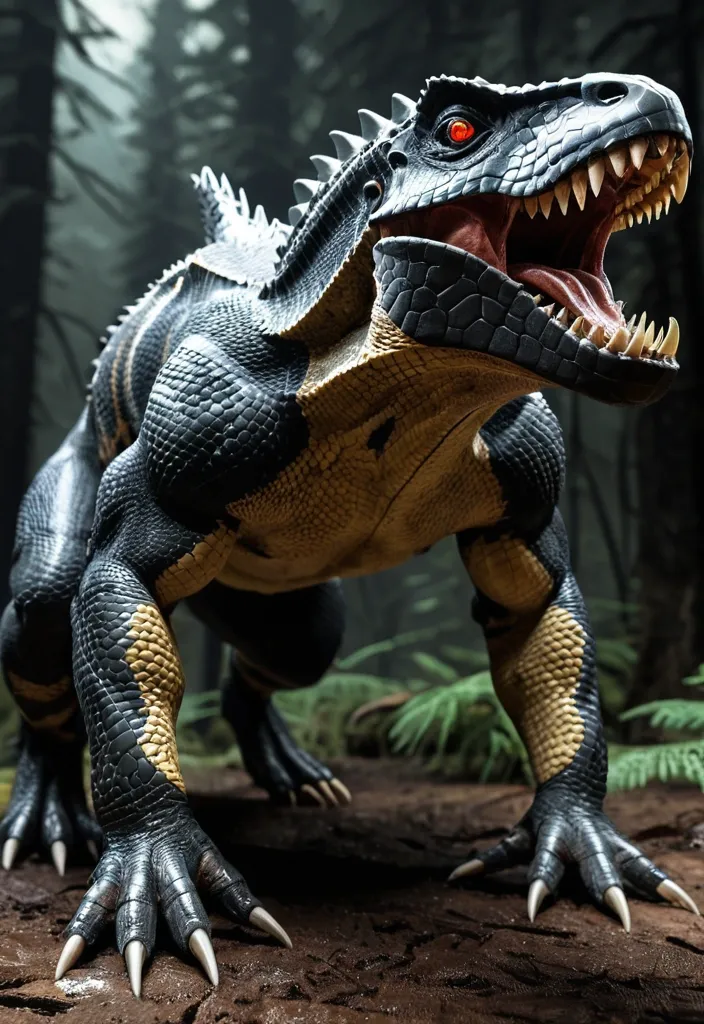
Physical Characteristics: Size & Build: Towering at around 15 feet tall and 40 feet long , Venenosus Rex exhibits a robust , muscular build with bulky , reduced hind legs adapted for powerful knuckle-walking quadrupedal locomotion , inherited from its Ape DNA. Its stance is low and intimidating , allowing swift bursts of speed and stability. Head: The head is a terrifying blend of Tyrannosaurus rex , Giganotosaurus , and Triceratops shapes—a broad , armored skull with a reinforced bony frill and horn-like protrusions from Triceratops , providing natural defense. Its jaw can open up to 90 degrees , snake-like , capable of delivering crushing bites able to shatter bulletproof glass. Skin & Camouflage: Covered in thick , overlapping Scelidosaurus-like osteoderm armor plates along the back and flanks , providing excellent protection against attacks. The skin contains chromatophore cells from cuttlefish DNA , allowing Venenosus Rex to dynamically change skin color , texture , and pattern for camouflage or intimidation. Arms & Claws: Long , powerful arms inspired by Saurophaganax and Ape DNA end in razor-sharp , hooked claws capable of slashing through armored prey and wielding tools for complex hunting strategies. Teeth & Fangs: Teeth are a deadly combination from the Inland Taipan’s retractable fangs , Komodo Dragon’s serrated teeth , and Northern short-tailed shrew’s sharp incisors , allowing it to pierce armor and inject highly toxic saliva into prey. Eyes & Senses: Equipped with specialized cranial cavities housing infrared vision , enabling night hunting and detection of body heat signatures. Its olfactory and auditory senses are exceptionally refined due to Utahraptor and Komodo Dragon ancestry. Unique Abilities: Extreme Environmental Resistance: Thanks to Tardigrade , Opossum , and Mongoose DNA , Venenosus Rex can survive extreme temperatures , radiation , dehydration , starvation , and bacterial infections. Its organs are shielded by trehalose gel , and its DNA is protected by specialized proteins against radiation damage. It can slow its metabolism down to 0.01% of normal , entering a near-hibernative state during harsh conditions. Toxic Saliva & Venom: Its saliva contains potent neurotoxins and anticoagulants , ensuring even minor bites are deadly over time. Combined with its retractable fangs , it can efficiently incapacitate prey or rivals. Camouflage & Stealth: Dynamic skin color and texture changes allow it to blend seamlessly into diverse environments or mimic threatening patterns to intimidate. Intelligence & Pack Hunting: Enhanced Utahraptor DNA grants high cognitive abilities , including planning , problem-solving , and social pack hunting tactics , making it a highly strategic predator. Tool Use: The combination of long , dexterous arms and ape DNA allows it to manipulate objects , set traps , or use environmental tools during hunts. Wide Jaw Opening: The ability to open its jaw at a 90-degree angle allows for impressive bite range and prey handling , intimidating foes with sudden wide gapes. ,
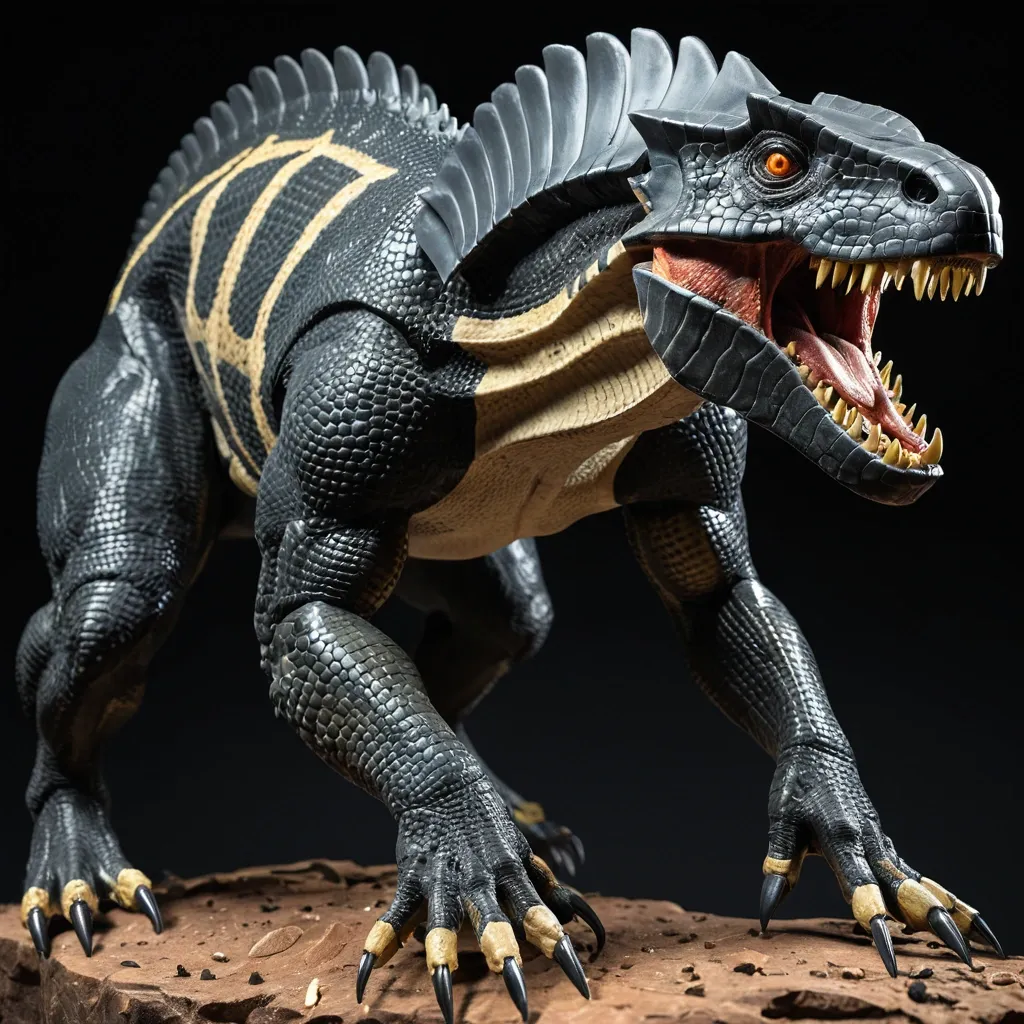
Physical Characteristics: Size & Build: Towering at around 15 feet tall and 40 feet long , Venenosus Rex exhibits a robust , muscular build with bulky , reduced hind legs adapted for powerful knuckle-walking quadrupedal locomotion , inherited from its Ape DNA. Its stance is low and intimidating , allowing swift bursts of speed and stability. Head: The head is a terrifying blend of Tyrannosaurus rex , Giganotosaurus , and Triceratops shapes—a broad , armored skull with a reinforced bony frill and horn-like protrusions from Triceratops , providing natural defense. Its jaw can open up to 90 degrees , snake-like , capable of delivering crushing bites able to shatter bulletproof glass. Skin & Camouflage: Covered in thick , overlapping Scelidosaurus-like osteoderm armor plates along the back and flanks , providing excellent protection against attacks. The skin contains chromatophore cells from cuttlefish DNA , allowing Venenosus Rex to dynamically change skin color , texture , and pattern for camouflage or intimidation. Arms & Claws: Long , powerful arms inspired by Saurophaganax and Ape DNA end in razor-sharp , hooked claws capable of slashing through armored prey and wielding tools for complex hunting strategies. Teeth & Fangs: Teeth are a deadly combination from the Inland Taipan’s retractable fangs , Komodo Dragon’s serrated teeth , and Northern short-tailed shrew’s sharp incisors , allowing it to pierce armor and inject highly toxic saliva into prey. Eyes & Senses: Equipped with specialized cranial cavities housing infrared vision , enabling night hunting and detection of body heat signatures. Its olfactory and auditory senses are exceptionally refined due to Utahraptor and Komodo Dragon ancestry. Unique Abilities: Extreme Environmental Resistance: Thanks to Tardigrade , Opossum , and Mongoose DNA , Venenosus Rex can survive extreme temperatures , radiation , dehydration , starvation , and bacterial infections. Its organs are shielded by trehalose gel , and its DNA is protected by specialized proteins against radiation damage. It can slow its metabolism down to 0.01% of normal , entering a near-hibernative state during harsh conditions. Toxic Saliva & Venom: Its saliva contains potent neurotoxins and anticoagulants , ensuring even minor bites are deadly over time. Combined with its retractable fangs , it can efficiently incapacitate prey or rivals. Camouflage & Stealth: Dynamic skin color and texture changes allow it to blend seamlessly into diverse environments or mimic threatening patterns to intimidate. Intelligence & Pack Hunting: Enhanced Utahraptor DNA grants high cognitive abilities , including planning , problem-solving , and social pack hunting tactics , making it a highly strategic predator. Tool Use: The combination of long , dexterous arms and ape DNA allows it to manipulate objects , set traps , or use environmental tools during hunts. Wide Jaw Opening: The ability to open its jaw at a 90-degree angle allows for impressive bite range and prey handling , intimidating foes with sudden wide gapes. ,
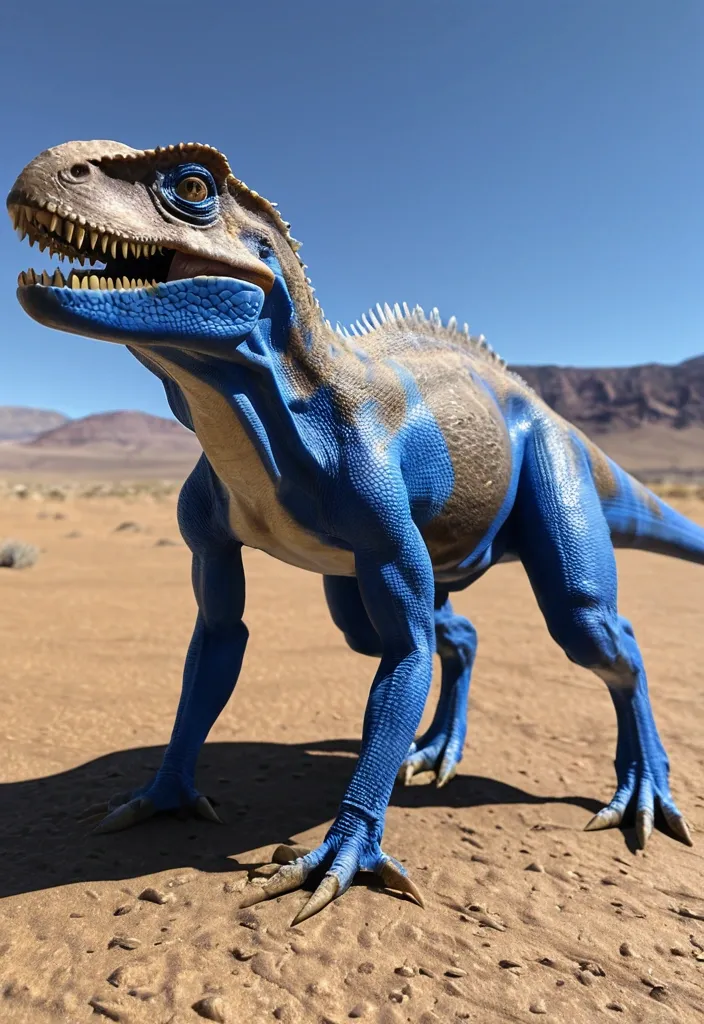
The hybrid was created by modifying the genome of a Tyrannosaurus rex , with the DNA of three other theropod species that were Utahraptor , Saurophaganax , and Giganotosaurus. Also the DNA of Quadrupes like Triceratops , Scelidosaurus , Gigantopithecus. DNA of modern animals such as Greater blue-ringed octopus , Inland Taipan , Northern Short-tailed Shrew , Komodo Dragon , Opossum , Mongoose , Whiptail Lizard , Cuttlefish , and Tardigrades. The genome of Tyrannosaurus rex , Utahraptor , Saurophaganax , and Giganotosaurus was used as the base genome for the hybrid. The shape of the headcrest is from the Triceratops. Utahraptor DNA was added for high levels of intelligence and the ability to make plans , decisions and pack hunting. Gigantopithecus DNA added for Knuckle-walking. Triceratops , and Scelidosaurus armor added a biological form of armor that absorbed most of the incoming attacks. Northern short-tailed shrew iron teeth , the Inland taipan's retractable fangs and the Komodo Dragon serrated teeth genome was used to form the teething of the hybrid. Saurophaganax and Gigantopithecus DNA added the presence of long strong arms with slashing hook claws and the use of tools. Cuttlefish genes were intended to help the hybrid withstand an accelerated growth , but it also added chromatophore cells in the skin so it could change the shape , color , and texture of its skin like a cuttlefish. Opossum , Mongoose and Tardigrades DNA was added for the hybrid to be more resistant to climate changes , harmful toxins or bacterial infections , while tardigrades also added survival of extreme conditions such as exposure to extreme temperatures , extreme pressures , air deprivation , radiation , dehydration , and starvation. Northern short-tailed shrew , the Inland Taipan , Greater blue-ringed octopus and the Komodo Dragon's DNA also added special cavities and glands in the skull that gave her infrared vision , and highly toxic saliva. Said DNA also gave her the ability to open her mandibles and jaws as wide as a snake , specifically at around 90 degrees.Lastly , DNA from a whiptail lizard was added for reproduction purposes. ,

The hybrid was created by modifying the genome of a Tyrannosaurus rex , with the DNA of three other theropod species that were Utahraptor , Saurophaganax , and Giganotosaurus. Also the DNA of Quadrupes like Triceratops , Scelidosaurus , Gigantopithecus. DNA of modern animals such as Greater blue-ringed octopus , Inland Taipan , Northern Short-tailed Shrew , Komodo Dragon , Opossum , Mongoose , Whiptail Lizard , Cuttlefish , and Tardigrades. The genome of Tyrannosaurus rex , Utahraptor , Saurophaganax , and Giganotosaurus was used as the base genome for the hybrid. The shape of the headcrest is from the Triceratops. Utahraptor DNA was added for high levels of intelligence and the ability to make plans , decisions and pack hunting. Gigantopithecus DNA added for Knuckle-walking. Triceratops , and Scelidosaurus armor added a biological form of armor that absorbed most of the incoming attacks. Northern short-tailed shrew iron teeth , the Inland taipan's retractable fangs and the Komodo Dragon serrated teeth genome was used to form the teething of the hybrid. Saurophaganax and Gigantopithecus DNA added the presence of long strong arms with slashing hook claws and the use of tools. Cuttlefish genes were intended to help the hybrid withstand an accelerated growth , but it also added chromatophore cells in the skin so it could change the shape , color , and texture of its skin like a cuttlefish. Opossum , Mongoose and Tardigrades DNA was added for the hybrid to be more resistant to climate changes , harmful toxins or bacterial infections , while tardigrades also added survival of extreme conditions such as exposure to extreme temperatures , extreme pressures , air deprivation , radiation , dehydration , and starvation. Northern short-tailed shrew , the Inland Taipan , Greater blue-ringed octopus and the Komodo Dragon's DNA also added special cavities and glands in the skull that gave her infrared vision , and highly toxic saliva. Said DNA also gave her the ability to open her mandibles and jaws as wide as a snake , specifically at around 90 degrees.Lastly , DNA from a whiptail lizard was added for reproduction purposes. ,
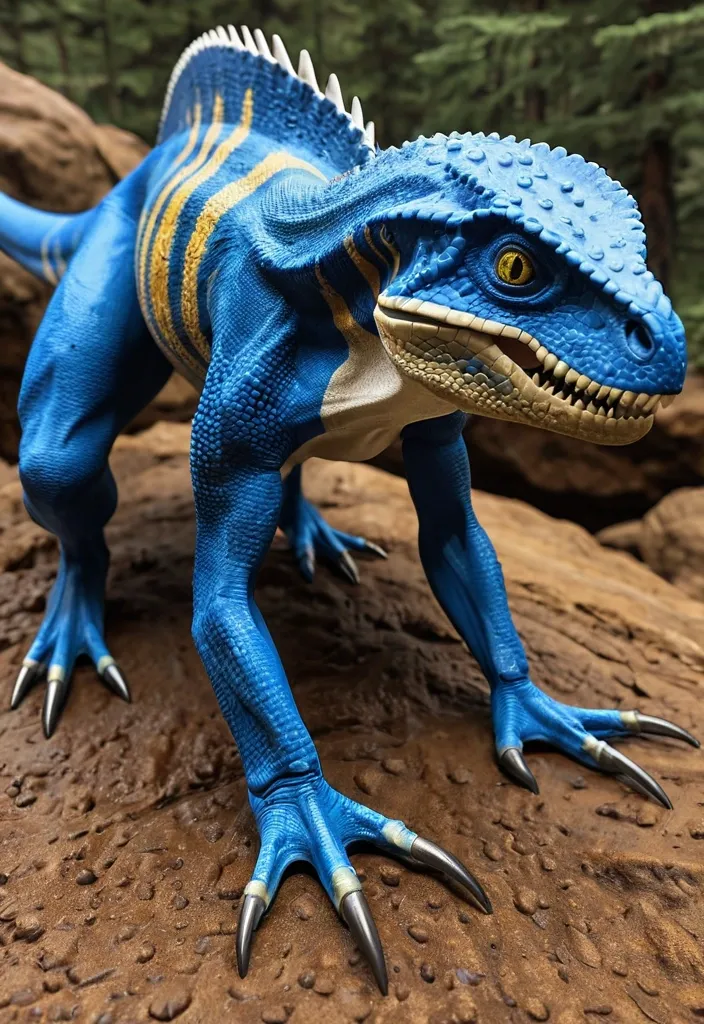
The hybrid was created by modifying the genome of a Tyrannosaurus rex , with the DNA of three other theropod species that were Utahraptor , Saurophaganax , and Giganotosaurus. Also the DNA of Quadrupes like Triceratops , Scelidosaurus , Gigantopithecus. DNA of modern animals such as Greater blue-ringed octopus , Inland Taipan , Northern Short-tailed Shrew , Komodo Dragon , Opossum , Mongoose , Whiptail Lizard , Cuttlefish , and Tardigrades. The genome of Tyrannosaurus rex , Utahraptor , Saurophaganax , and Giganotosaurus was used as the base genome for the hybrid. The shape of the headcrest is from the Triceratops. Utahraptor DNA was added for high levels of intelligence and the ability to make plans , decisions and pack hunting. Gigantopithecus DNA added for Knuckle-walking. Triceratops , and Scelidosaurus armor added a biological form of armor that absorbed most of the incoming attacks. Northern short-tailed shrew iron teeth , the Inland taipan's retractable fangs and the Komodo Dragon serrated teeth genome was used to form the teething of the hybrid. Saurophaganax and Gigantopithecus DNA added the presence of long strong arms with slashing hook claws and the use of tools. Cuttlefish genes were intended to help the hybrid withstand an accelerated growth , but it also added chromatophore cells in the skin so it could change the shape , color , and texture of its skin like a cuttlefish. Opossum , Mongoose and Tardigrades DNA was added for the hybrid to be more resistant to climate changes , harmful toxins or bacterial infections , while tardigrades also added survival of extreme conditions such as exposure to extreme temperatures , extreme pressures , air deprivation , radiation , dehydration , and starvation. Northern short-tailed shrew , the Inland Taipan , Greater blue-ringed octopus and the Komodo Dragon's DNA also added special cavities and glands in the skull that gave her infrared vision , and highly toxic saliva. Said DNA also gave her the ability to open her mandibles and jaws as wide as a snake , specifically at around 90 degrees.Lastly , DNA from a whiptail lizard was added for reproduction purposes. ,
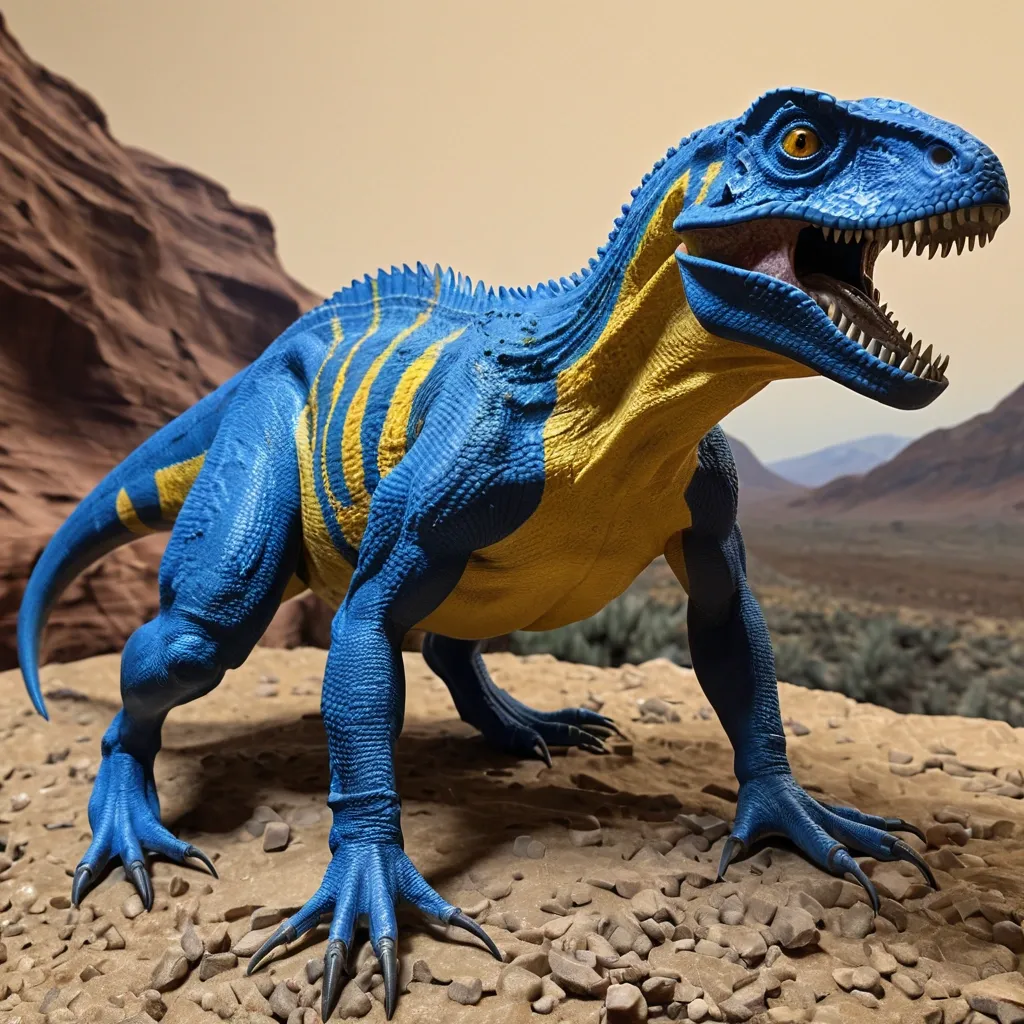
The hybrid was created by modifying the genome of a Tyrannosaurus rex , with the DNA of three other theropod species that were Utahraptor , Saurophaganax , and Giganotosaurus. Also the DNA of Quadrupes like Triceratops , Scelidosaurus , Gigantopithecus. DNA of modern animals such as Greater blue-ringed octopus , Inland Taipan , Northern Short-tailed Shrew , Komodo Dragon , Opossum , Mongoose , Whiptail Lizard , Cuttlefish , and Tardigrades. The genome of Tyrannosaurus rex , Utahraptor , Saurophaganax , and Giganotosaurus was used as the base genome for the hybrid. The shape of the headcrest is from the Triceratops. Utahraptor DNA was added for high levels of intelligence and the ability to make plans , decisions and pack hunting. Gigantopithecus DNA added for Knuckle-walking. Triceratops , and Scelidosaurus armor added a biological form of armor that absorbed most of the incoming attacks. Northern short-tailed shrew iron teeth , the Inland taipan's retractable fangs and the Komodo Dragon serrated teeth genome was used to form the teething of the hybrid. Saurophaganax and Gigantopithecus DNA added the presence of long strong arms with slashing hook claws and the use of tools. Cuttlefish genes were intended to help the hybrid withstand an accelerated growth , but it also added chromatophore cells in the skin so it could change the shape , color , and texture of its skin like a cuttlefish. Opossum , Mongoose and Tardigrades DNA was added for the hybrid to be more resistant to climate changes , harmful toxins or bacterial infections , while tardigrades also added survival of extreme conditions such as exposure to extreme temperatures , extreme pressures , air deprivation , radiation , dehydration , and starvation. Northern short-tailed shrew , the Inland Taipan , Greater blue-ringed octopus and the Komodo Dragon's DNA also added special cavities and glands in the skull that gave her infrared vision , and highly toxic saliva. Said DNA also gave her the ability to open her mandibles and jaws as wide as a snake , specifically at around 90 degrees.Lastly , DNA from a whiptail lizard was added for reproduction purposes. ,
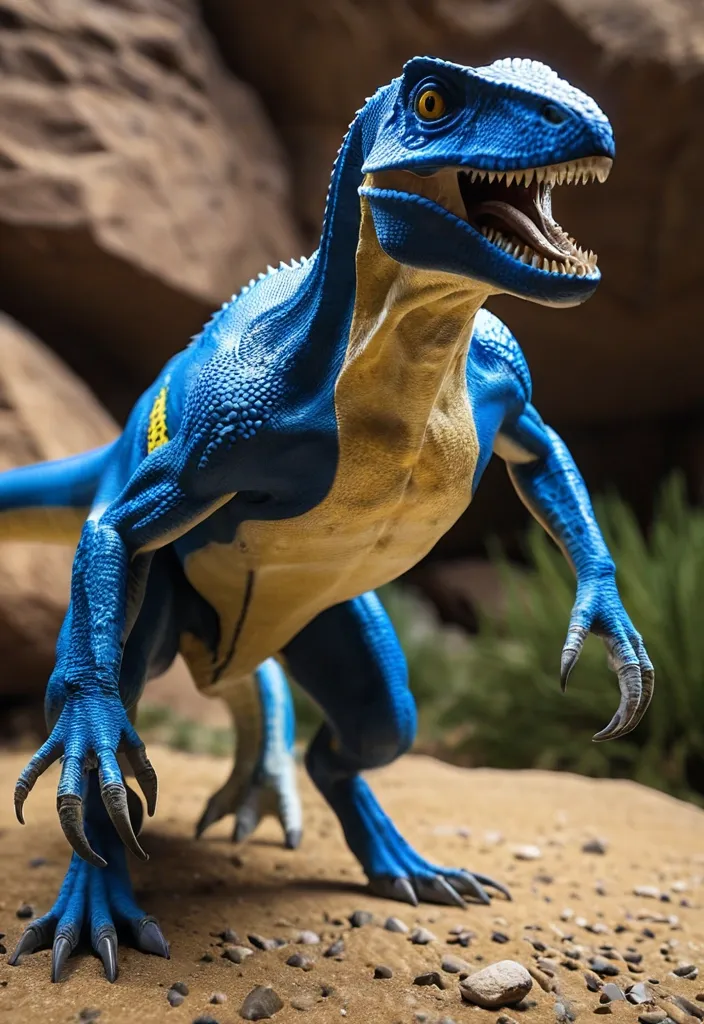
The hybrid was created by modifying the genome of a Tyrannosaurus rex , with the DNA of three other theropod species that were Utahraptor , Saurophaganax , and Giganotosaurus. Also the DNA of Quadrupes like Triceratops , Scelidosaurus , Gigantopithecus. DNA of modern animals such as Greater blue-ringed octopus , Inland Taipan , Northern Short-tailed Shrew , Komodo Dragon , Opossum , Mongoose , Whiptail Lizard , Cuttlefish , and Tardigrades. The genome of Tyrannosaurus rex , Utahraptor , Saurophaganax , and Giganotosaurus was used as the base genome for the hybrid. The shape of the headcrest is from the Triceratops. Utahraptor DNA was added for high levels of intelligence and the ability to make plans , decisions and pack hunting. Gigantopithecus DNA added for Knuckle-walking. Triceratops , and Scelidosaurus armor added a biological form of armor that absorbed most of the incoming attacks. Northern short-tailed shrew iron teeth , the Inland taipan's retractable fangs and the Komodo Dragon serrated teeth genome was used to form the teething of the hybrid. Saurophaganax and Gigantopithecus DNA added the presence of long strong arms with slashing hook claws and the use of tools. Cuttlefish genes were intended to help the hybrid withstand an accelerated growth , but it also added chromatophore cells in the skin so it could change the shape , color , and texture of its skin like a cuttlefish. Opossum , Mongoose and Tardigrades DNA was added for the hybrid to be more resistant to climate changes , harmful toxins or bacterial infections , while tardigrades also added survival of extreme conditions such as exposure to extreme temperatures , extreme pressures , air deprivation , radiation , dehydration , and starvation. Northern short-tailed shrew , the Inland Taipan , Greater blue-ringed octopus and the Komodo Dragon's DNA also added special cavities and glands in the skull that gave her infrared vision , and highly toxic saliva. Said DNA also gave her the ability to open her mandibles and jaws as wide as a snake , specifically at around 90 degrees.Lastly , DNA from a whiptail lizard was added for reproduction purposes. ,
